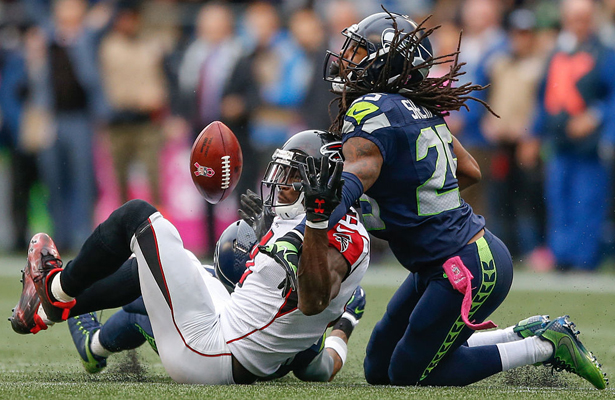-
Final
TB
ATL23
20 -
Final
CIN
CLE17
16 -
Final
MIA
IND8
33 -
Final
CAR
JAX10
26 -
Final
LV
NE20
13 -
Final
AZ
NO20
13 -
Final
PIT
NYJ34
32 -
Final
NYG
WAS6
21 -
Final
TEN
DEN12
20 -
Final
SF
SEA17
13 -
Final
DET
GB13
27 -
Final
HOU
LAR9
14 -
Final
BAL
BUF40
41 -
Final
MIN
CHI27
24 -
Final
DAL
PHI20
24 -
Final
KC
LAC21
27
No Call, No Win
- Updated: October 17, 2016

Julio Jones had Richard Sherman beat twice in the final four minutes Sunday. Those plays resulted in an interception off a drop by Jones and an incompletion on what appeared to be textbook pass interference by Sherman.
If this is what it takes to beat the Falcons, to slow down their creative and potent offense, then there are going to be a lot more good days than bad for Atlanta from here on out.
The Seahawks won’t complain about how they eked their way to a 26–24 win on Sunday afternoon. With it, they’re now 4–1 and already starting to pull away from their NFC West rivals. They staked themselves to a 17–3 halftime lead by pummeling Matt Ryan, many times through deploying linebacker Bobby Wagner on blitzes. And when fortune smiled upon them in the closing moments, they took advantage: Earl Thomas made sure that Jones drop turned into a pick, then the Seattle offense picked up 24 yards to get struggling kicker Steven Hauschka into field-goal range.
Atlanta showed for the second Sunday in a row that it will pose a formidable test all year. Last week, the Falcons stormed into Denver and steamrolled the Super Bowl champs. This time around, they shook off a difficult first half to score three straight third-quarter touchdowns, putting them in position for another road win.
It didn’t happen in the end, but that shouldn’t diminish that post-halftime stretch.
Ryan was under siege in the first half, either hit or sacked on 11 of his 17 passing attempts over the game’s first 20 minutes. One sack, by Seattle’s Cliff Avril, forced a fumble that the Seahawks recovered and turned into a touchdown a play later. Ryan did not have time to look for anyone downfield, let alone to allow Jones to work open against Sherman.
That all changed in the third quarter. Offensive coordinator Kyle Shanahan made several tweaks to his game plan: extra blockers, a steady stream of play-action rollouts to get Ryan clear of the pocket and more looks for Jones in the slot to free him from Sherman.
The final trick paid off on Atlanta’s first touchdown, a 36-yard pass from Ryan to Jones. Sherman initially lined up opposite Jones on the play, then shifted outside when tight end Austin Hooper came across in motion, leaving Jones in the slot. As Sherman tracked Hooper, Jones ran right past a confused Kelcie McCray for a wide-open touchdown.
Sherman stormed to the sideline, fired his helmet to the ground and had words with several Seahawks, including defensive coordinator Kris Richard. The frustration would only grow from there.
Ryan found Jones twice in a row for 40 yards to open the next drive, then capped that possession with a 10-yard TD to Mohamed Sanu. Following a Seattle punt moments later, Atlanta moved 98 yards in just six plays—a 24-yard pass to Jones preceded a 46-yard touchdown to tight end Levine Toilolo on what looked like another busted coverage.
Seattle did right the ship in the fourth quarter, snuffing out an Atlanta drive with a third-down sack by Cassius Marsh. On that play, Sherman was locked on Jones as he cut across the middle of the field, with Jeremy Lane providing support.
Even so, after an ensuing Seattle touchdown trimmed Atlanta’s lead to one, the Seahawks still needed another stop. Were it not for Jones letting a ball slip through his fingers—after seven previous catches for 139 yards—the Falcons might have been able to run out the clock or add insurance points.
The controversy at the end of the game might not go away anytime soon, not if Atlanta and Seattle wind up in a battle for home-field advantage in the NFC playoffs. The Seahawks again managed to fluster Ryan with pressure on first, second and third down. (Ryan had room to scramble on third-and-10 but threw incomplete to Mohamed Sanu.)
On fourth down, Ryan gave his best receiver a shot, despite double coverage from Sherman and Earl Thomas. Had the flag on Sherman been thrown—as it probably should have—the Falcons would have had the ball inside Seattle’s 40 with 1:31 to play.
